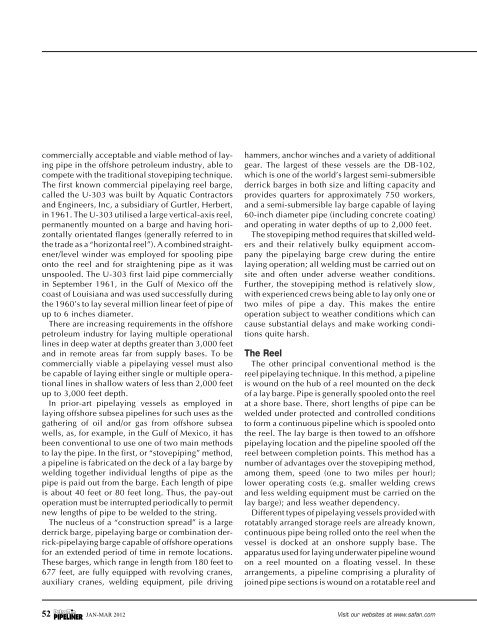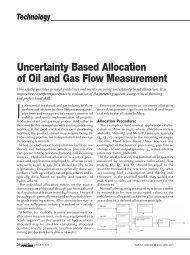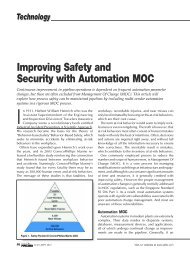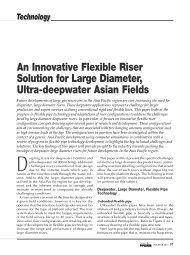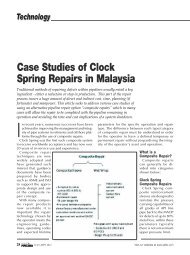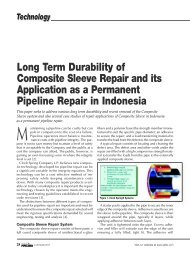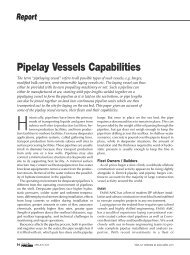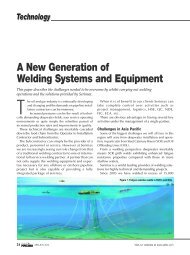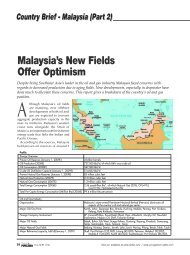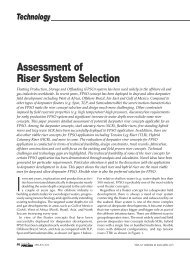Pipelay Vessels and Techniques - PetroMin Pipeliner
Pipelay Vessels and Techniques - PetroMin Pipeliner
Pipelay Vessels and Techniques - PetroMin Pipeliner
You also want an ePaper? Increase the reach of your titles
YUMPU automatically turns print PDFs into web optimized ePapers that Google loves.
commercially acceptable <strong>and</strong> viable method of laying<br />
pipe in the offshore petroleum industry, able to<br />
compete with the traditional stovepiping technique.<br />
The first known commercial pipelaying reel barge,<br />
called the U-303 was built by Aquatic Contractors<br />
<strong>and</strong> Engineers, Inc, a subsidiary of Gurtler, Herbert,<br />
in 1961. The U-303 utilised a large vertical-axis reel,<br />
permanently mounted on a barge <strong>and</strong> having horizontally<br />
orientated flanges (generally referred to in<br />
the trade as a “horizontal reel”). A combined straightener/level<br />
winder was employed for spooling pipe<br />
onto the reel <strong>and</strong> for straightening pipe as it was<br />
unspooled. The U-303 first laid pipe commercially<br />
in September 1961, in the Gulf of Mexico off the<br />
coast of Louisiana <strong>and</strong> was used successfully during<br />
the 1960’s to lay several million linear feet of pipe of<br />
up to 6 inches diameter.<br />
There are increasing requirements in the offshore<br />
petroleum industry for laying multiple operational<br />
lines in deep water at depths greater than 3,000 feet<br />
<strong>and</strong> in remote areas far from supply bases. To be<br />
commercially viable a pipelaying vessel must also<br />
be capable of laying either single or multiple operational<br />
lines in shallow waters of less than 2,000 feet<br />
up to 3,000 feet depth.<br />
In prior-art pipelaying vessels as employed in<br />
laying offshore subsea pipelines for such uses as the<br />
gathering of oil <strong>and</strong>/or gas from offshore subsea<br />
wells, as, for example, in the Gulf of Mexico, it has<br />
been conventional to use one of two main methods<br />
to lay the pipe. In the first, or “stovepiping” method,<br />
a pipeline is fabricated on the deck of a lay barge by<br />
welding together individual lengths of pipe as the<br />
pipe is paid out from the barge. Each length of pipe<br />
is about 40 feet or 80 feet long. Thus, the pay-out<br />
operation must be interrupted periodically to permit<br />
new lengths of pipe to be welded to the string.<br />
The nucleus of a “construction spread” is a large<br />
derrick barge, pipelaying barge or combination derrick-pipelaying<br />
barge capable of offshore operations<br />
for an extended period of time in remote locations.<br />
These barges, which range in length from 180 feet to<br />
677 feet, are fully equipped with revolving cranes,<br />
auxiliary cranes, welding equipment, pile driving<br />
hammers, anchor winches <strong>and</strong> a variety of additional<br />
gear. The largest of these vessels are the DB-102,<br />
which is one of the world’s largest semi-submersible<br />
derrick barges in both size <strong>and</strong> lifting capacity <strong>and</strong><br />
provides quarters for approximately 750 workers,<br />
<strong>and</strong> a semi-submersible lay barge capable of laying<br />
60-inch diameter pipe (including concrete coating)<br />
<strong>and</strong> operating in water depths of up to 2,000 feet.<br />
The stovepiping method requires that skilled welders<br />
<strong>and</strong> their relatively bulky equipment accompany<br />
the pipelaying barge crew during the entire<br />
laying operation; all welding must be carried out on<br />
site <strong>and</strong> often under adverse weather conditions.<br />
Further, the stovepiping method is relatively slow,<br />
with experienced crews being able to lay only one or<br />
two miles of pipe a day. This makes the entire<br />
operation subject to weather conditions which can<br />
cause substantial delays <strong>and</strong> make working conditions<br />
quite harsh.<br />
The Reel<br />
The other principal conventional method is the<br />
reel pipelaying technique. In this method, a pipeline<br />
is wound on the hub of a reel mounted on the deck<br />
of a lay barge. Pipe is generally spooled onto the reel<br />
at a shore base. There, short lengths of pipe can be<br />
welded under protected <strong>and</strong> controlled conditions<br />
to form a continuous pipeline which is spooled onto<br />
the reel. The lay barge is then towed to an offshore<br />
pipelaying location <strong>and</strong> the pipeline spooled off the<br />
reel between completion points. This method has a<br />
number of advantages over the stovepiping method,<br />
among them, speed (one to two miles per hour);<br />
lower operating costs (e.g. smaller welding crews<br />
<strong>and</strong> less welding equipment must be carried on the<br />
lay barge); <strong>and</strong> less weather dependency.<br />
Different types of pipelaying vessels provided with<br />
rotatably arranged storage reels are already known,<br />
continuous pipe being rolled onto the reel when the<br />
vessel is docked at an onshore supply base. The<br />
apparatus used for laying underwater pipeline wound<br />
on a reel mounted on a floating vessel. In these<br />
arrangements, a pipeline comprising a plurality of<br />
joined pipe sections is wound on a rotatable reel <strong>and</strong><br />
52 JAN-MAR 2012 Visit our websites at www.safan.com


